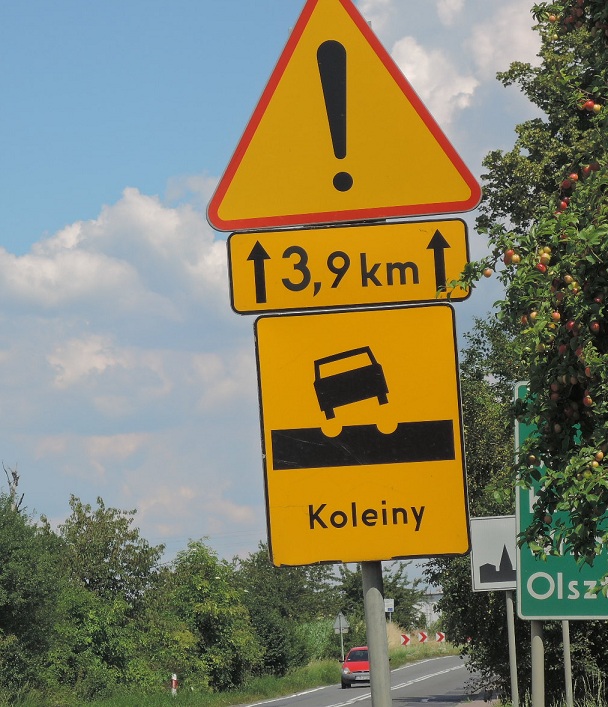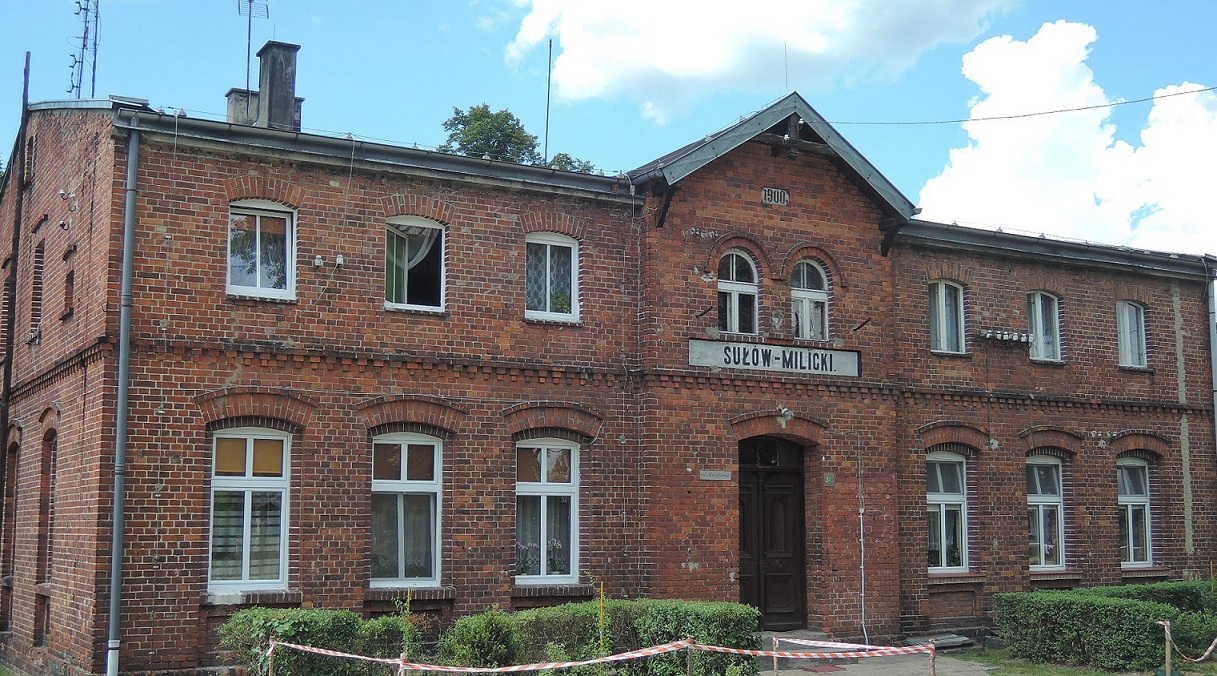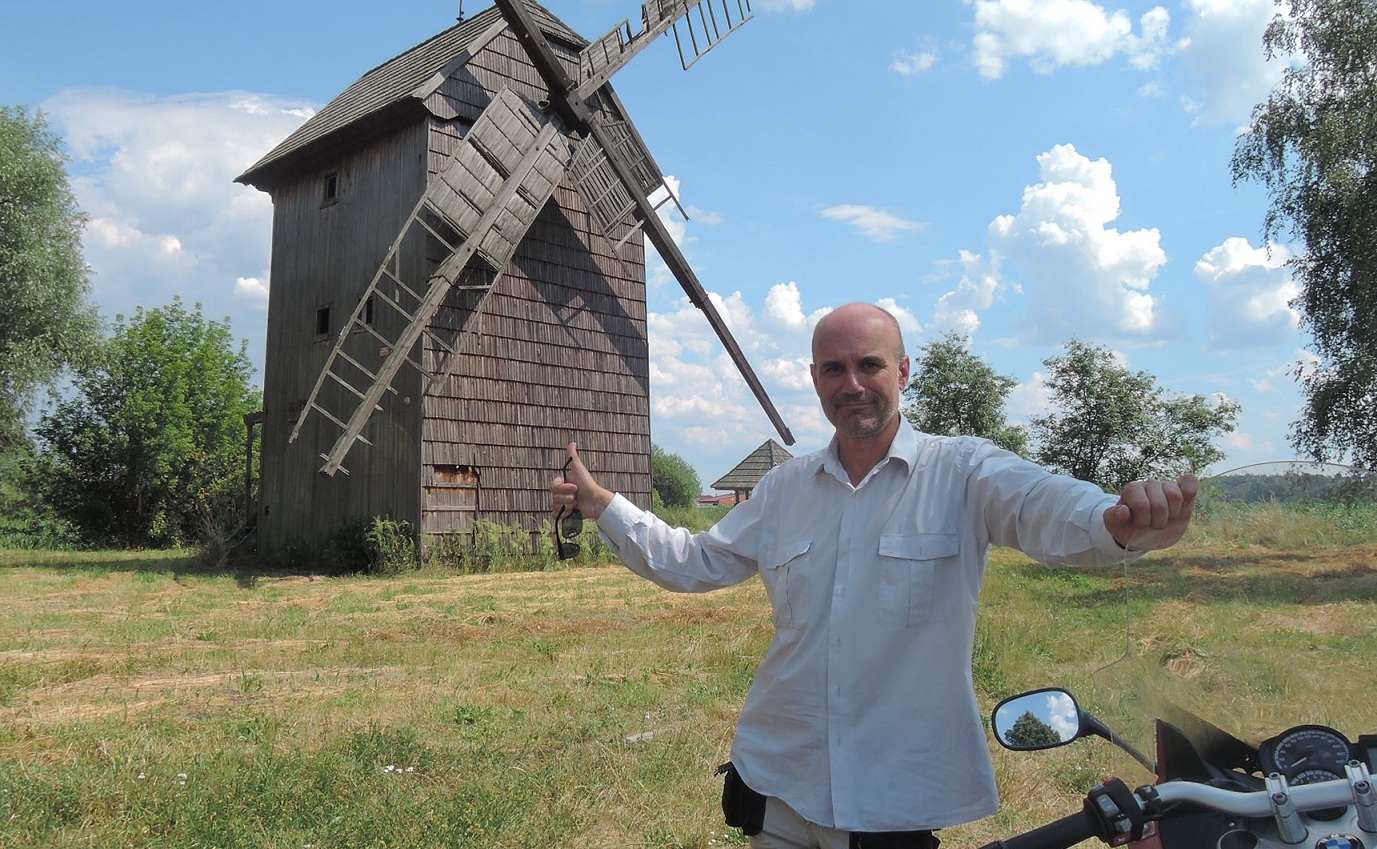Driving in Poland is something of a challenge for which we, riders, must maximize carefulness; in every sense.
Despite having a vast railroad network reaching every corner and village in the country, when this nation got out of the socialist orbit and into the European one they opted for the dead-easy and short sighted bet: road transportation. Instead of modernizing their tracks, trains and railway facilities, they surrendered to the powerful engine industry and, since then, invest the developement funds in road infrastructure and in favouring the use (or at least the purchase) of cars and trucks. Hence, its routes have a busy traffic, which on top of their aggressive driving habits and the bad pavement of yet many of their roads, results in a somewhat dangerous driving experience.
Poland is, for instance, the only country where I’ve seen this road sign:
Koleiny are two parallel, lengthwise permanent hollows produced on the melting asphalt by the pass of heavy trailers on very hot days. These depressions can “get hold” of the wheel and make us lose control of the steering. On a motorcycle it’s even more dangerous, because of the pavement’s unevenness.
On the other hand, it’s common to overtake on a double line here and with front coming traffic, provided the road is “wide enough”. Such speedy maniacs take for granted that both the overtaken vehicle and the one coming opposite will pull to the shoulders to allow them pass; and don’t think of complaining, because they’ll give you the finger and, if need be, try to make you stop to start a fight, which is one of the favourite passtimes in slavic cultures. And of course Poles love speeding up and also chain overtakings. So, with all these features, the foreigner venturing to drive in this country must take it very easy and be on the watch.
Along this trip I’m always chosing by-roads, but this has proven to be a mistake in Poland, where such routes are often in very bad shape, the pavement being so bumpy that you might think you’re driving on cobblestones.
I’ve spent three days on a more or less straight route, on secondary roads, from Miedzylesie to Torun (my next important stop). First I crossed Wroclaw, a beautiful city which is as quickly losing its character as it’s developing fast, and where I stayed overnight for visiting a friend. Then I kept going north, crossing endless fields, meadows and agricultural lands under a strong sunshine, temperatures having reached 37 stifling Celsius. In summer, this country has — despite my Polish friends laughing when I tell them — a rather tropical climate, with much hot and humidity, which ends up in frequent and dramatic evening thunderstorms. One of these, quite heavy, fell the day I was making a stopover in Jarocin, a town in the middle of this boring region. Luckily rain started at dusk, when I was already under cover in the hotel.
As to “boring”, it’s fair to make clear that I mean only the roads; as, for the rest, and mostly if one knows how to look around with curious eyes, there are many interesting things in this country only yesterday orbiting around the Soviet socialism.
For example the railway stations, that fascinate me with their enduring brick buildings, almost always neglected if not derelict, their rails grid, the loading docks and those ever present, forgotten freight wagons on the dead ends; all of it witnesses of a not-so-far past, telling us, with their silence presence, of a life and activity that exist no more.
I leave for a better moment -one of those constantly procrastinated proyects- to make a trip and photographic report on all those hundreds, maybe thousands of Polish railway stations which, with their deserted look, seem to be dreaming of times that won’t ever come back.
Another one of Poland’s identity marks are the old windmills, no longer used, that we can find scattered along the whole country. I like to take my imagination to those days when families endeavoured together in their farming labours by these or similar constructions, those days when life was as hard for the body as it was easy for the soul, when loves took shape, grew and ripened in the country, and when there were no other changes demanding adaptation, for decades, than those imposed by the seasons. And even today, despite all the modernization and globalization, it’s not difficult to find in Poland dozens of towns or villages whose atmosphere reminds that of three decades ago.
Now, to get done with this chapter, behold the Virgin Mary, the other holy character (besides John Paul II) protecting the countryside, crops and houses, starring the lives of these people, traditionally so Catholic and devoted until the modern and sudden intrusion of global market and unhindered materialism have come to redeem them from their religious superstitions and open their eyes to the new gods, Fashion and Consumption.







Good article but the Polish people are like any other people in the world they now Drive one person in a 4 seat car and they love to be able to sit in comfort in there traffic jams and would rather do that then have to go into a train for distances that can be done in a nice car without other people. The Swiss have traffic jams the Germans have traffic jams the Americans have traffic jams even the other North and South Americans have traffic jams. What’s wrong with the Polish people getting out of there anachronistic modes of transportation. The bullet train is the only real answer too long distances on land. The ancient towns that can still be seen in Poland are real pretty to see I like them but get over your old churches and castles the future is coming with or without you. You rich Europeans can’t expect the rest of the world to stay poor so you can have a great experience in their country. I loved your article Beatles forever 🙂
Nice speech, but quite out of place. If you read carefully, you won’t see the word “wrong” in my article, nor the expression “traffic jam”. You’re perhaps refuting only to your own conscience.
For the rest, calling “anachronistic” anything but the car evidences a very narrow knowledge of our planet and societies. Perhaps the knowledge of someone who doesn’t want to know any better. And no sane person, for that matter, loves to sit in a traffic jam, no matter how comfortably.
In any case, you’re forgetting that Polish citizens haven’t taken that decision (going automobile) freely. The big capital has done it for them, at the cost of compromising their (and everyone else’s) new generations’ welfare. Though, of course, who cares about real freedom of choice? We wouldn’t know what to do with it.
You can’t love ancient Polish towns because you’ve never been there. Perhaps you should get over your missiles and warfare, and start watching the world with a real traveler’s eyes. Don’t worry: churches won’t harm you. Neither bees will. 🙂 Guns maybe.
Preaching “the future is coming with or without you” is like preaching “the street will get dirty with or without you, therefore go and litter”. Maybe it will, but with as little of my help as possible.
Funny your last sentence for someone who expects Africa to stay poor so he can have a great experience with the wild animals.